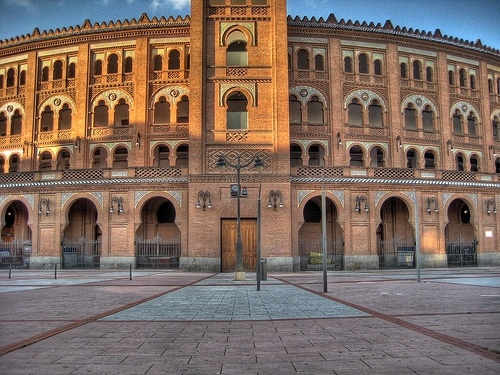CATEGORY | 1 day programs |
EXPERIENCE | Special Madrid |
PLACE | Museo Reina Sofía |
IF YOU'RE INTERESTED IN | Architecture | History | Literature | Modern Art |
Hemingway’s love for Pamplona is a widely known fact; but after that town, Madrid was the place in Spain he visited more often from 1923 to 1960. Orson Welles was also a regular visitor of Spain, from 1933 until 1967. What Hemingway and Welles witnessed here is an extraordinary American testimony of 40 crucial years of the Spanish history that we want to share with you through this guided tour.
Bullfighting had brought in Spain those two American cultural giants . Therefore, Las Ventas is a natural starting point for our tour. The monumental arena of Las Ventas and the picturesque neighborhood around it have preserved part of the ambience of a period when the whole city thrilled with the “Fiesta”.
1920’s and 30’s, when Hemingway and Welles came first to Spain, a new generation of intellectuals was renewing literature and the performing arts the very same way both Americans did. Many of those names (Lorca, Dalí, Buñuel, Alberti,...) are related to the “Residencia de Estudiantes”, sanctuary of our Spanish “lost generation”. Hemingway and Welles did never meet them there and then (as far as we know).
Hemingway became a great admirer of Lorca’s poetry once dead, and met Rafael Alberti only during the war; Welles kept distance with Buñuel and Dalí, although their paths crossed many times after the 1940’s.
The Spanish Civil War was the opportunity for a new series of Hemingway visits to Madrid. The Hotel Gaylord and the Anti-fascist Alliance, together with the Gran Vía, became locations for his novels and tales. Hemingway would meet there spies and war reporters, soldiers and adventurers, as well as John Dos Passos, Martha Gellhorn, Joris Ivens, Dorothy Parker, Lilian Hellman or Ilya Ehrenburg.
That was the time when he and Martha Gellhorn dwelled at the Hotel Florida, the most convenient for war reporters, close enough to his favorite eating and drinking spots. Gran Vía was a symbol that has to be smashed: through its architecture, it represented the progress that Spain had experienced since the 1910’s, and through its day and nightlife, the will of resistance of the pro-republican fighters.
Argüelles, Moncloa and the “Ciudad Universitaria” were the areas of the city closer to the front, the worst hit and most dangerous ones. Typically, Hemingway visited them and advised Ivens to choose a ruined house at Pintor Rosales 14 as a location for Ivens film “The Spanish Earth”, a documentary film whose narrator had to be Orson Welles. In the same area, Pablo Neruda’s house, the “Casa de las Flores”, a prototype of modernist architecture, would also be hit because of its proximity to the frontline.
After the war, reconstruction would change the whole area, with fascist architecture replacing some dramatic spots of the war (Cárcel Modelo, Cuartel de la Montaña) and setting the scenery for military parades and one-party society: Triumphal Arch, Museum of America, Air Force Ministry,…
But after the war, Hemingway returned to many of the places in the city he knew from the times of the war (or even before, like the “Pensión Aguilar” in Carrera de San Jerónimo 32, the Hotel Biarritz in Victoria 2 or the Cervecería Alemana) although now he could afford the Palace Hotel (where he would receive young writers, bullfighters and activists), just as Orson Welles, another regular visitor of its lounge & bar. Now being members of the international jet-set where lots of cinema stars (Sofia Loren, Ava Gardner, Tyrone Power, Nicholas Ray,…) met at places like Chicote, it is rather normal that they never entered El Rastro or Lavapiés again, with their distinctive proletarian culture and their loyalty to republicanism during the Franco years.
The Reina Sofía Museum would provide us with new opportunities to see Spanish history through Hemingway and Welles’ eyes. Hemingway would share his opinions on Picasso with us, while praising Juan Gris and Miró, who had painted his two dearest artistic treasures. Capa’s photographs and Quintanilla’s drawings would awaken his war memories. Welles would speak of Buñuel and Dalí with intense irony. And art from the 1940’s to 60’s would bear testimony of the many transformations of Franco’s regime that they had witnessed themselves.
The story line of this 10am-7pm tour would have give us the chance to see and understand 20th century Spain, as well as the historical city center of Madrid and two must-see landmarks: the Gran Vía and the Reina Sofía Museum.
If you wish information on how to follow the steps of Orson Welles and Ernest Hemingway through this private guided tour of Madrid, fill the form and we will contact you.


